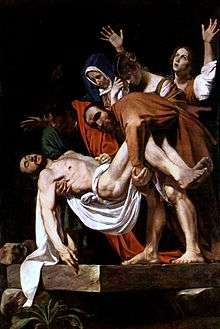Mary of Clopas

.jpg)
Mary of Clopas (or of Cleophas) (Ancient Greek: Μαρία ἡ τοῦ Κλωπᾶ, María hē tou Clōpá), the wife of Cleophas, was one of various Marys named in the New Testament.
Mary of Cleophas is explicitly mentioned only in John 19:25, where she is among the women present at the crucifixion of Jesus:
Now there stood by the cross of Jesus His mother, and His mother’s sister, Mary [the wife] of Clopas, and Mary Magdalene.
The expression Mary of Cleophas in the Greek text is ambiguous as to whether Mary was the daughter or wife of Cleophas, but exegesis has commonly favoured the reading "wife of Cleophas" (as reflected in above translation). Hegesippus thought that Cleophas was the brother of Saint Joseph.[1]
Gospel parallels
According to some interpretations, the same Mary was also among the women that on resurrection morning went to the tomb to anoint Jesus' body with spices. Matthew 28:1 calls her "the other Mary" to distinguish her from Mary Magdalene, while Mark 16:1 uses the name "Mary of James", most probably derived from James the Less. The Latin version of that name, Maria Iacobi is often used in tradition. Stephen S. Smalley (1982) says that it is "probable" (but not virtually certain) that Mary of Cleophas is Mary the mother of James son of Alphaeus.[2]
For detailed explanations, please see: Brothers of Jesus and James the brother of Jesus.
Apocryphal books
In a manner very similar to the Gospel of John, the apocryphal Gospel of Philip also seems to list Mary of Cleophas among Jesus' female entourage:
There were three who always walked with the Lord: Mary, his mother, and her sister, and Magdalene, the one who was called his companion. His sister and his mother and his companion were each a Mary.[note 1]
Adding to the confusion, the Gospel of Philip seems to refer to her as Jesus' mother's sister ("her sister") and Jesus' own sister ("his sister").
In the Gospel of Pseudo-Matthew, which was probably written in the seventh century, states that Mary of Cleophas was daughter of Cleophas and Anna:
Jesus met them, with Mary His mother, along with her sister Mary of Cleophas, whom the Lord God had given to her father Cleophas and her mother Anna, because they had offered Mary the mother of Jesus to the Lord. And she was called by the same name, Mary, for the consolation of her parents.[3]
The most common interpretation is that "of Cleopas" indicates the husband of Mary of Cleophas and subsequently the father of her children, but some see "of Cleophas" as meaning this Mary's father. In medieval tradition Cleophas is the second husband of Saint Anne and the father of "Mary of Cleophas".[4]
Catholic and Orthodox traditions believed that Clopas is a brother of Saint Joseph, and that he is the same person with Cleopas.[5][6][7]
Traditions
An early tradition within the Roman Catholic Church identify Mary of Cleophas being the sister (or sister-in-law) of Mary the Mother of Jesus. Eusebius of Caesarea citing Hegesippus records that "Cleophas was a brother of Joseph",[8] which makes Mary of Cleophas a sister-in-law of Mary, the mother of Jesus.
Jerome identifies Mary of Cleophas as the sister of Mary, mother of Jesus and as the mother of those who were called the brothers and sisters of Jesus.[9]
According to the surviving fragments of the work Exposition of the Sayings of the Lord of the Apostolic Father Papias of Hierapolis, who lived circa 70-163 AD, Mary of Cleophas would be the mother of James the Just, Simon, Judas (identified as Jude the Apostle), and Joseph (Joses). Papias identifies this "Mary" as the sister of Mary, mother of Jesus, and thus as the maternal aunt of Jesus.[10] The Anglican theologian J.B. Lightfoot dismissed Papias' evidence as spurious.[11][12]
In the Roman Martyrology she is remembered with Saint Salome on April 24. Some have regarded Mary as the daughter of Clopas, who was in turn one of the husbands of Saint Anne.[13]
See also
Notes
- ↑ The Old and New Testament and Gnostic contexts and the text are discussed by Robert M. Grant, "The Mystery of Marriage in the Gospel of Philip" Vigiliae Christianae 15.3 (September 1961:129-140).
References
| Wikisource has the text of the 1913 Catholic Encyclopedia article Mary of Cleophas. |
| Wikimedia Commons has media related to Mary of Clopas. |
- ↑ Eusebius of Caesarea, Church History, Book III, ch. 11.
- ↑ S. S. Smalley, Dean Emeritus of Chester Cathedral, England. "Mary," New Bible Dictionary, 1982 p. 793.
- ↑ The Gospel of Pseudo-Matthew. Retrieved 19 June 2018.
- ↑

- ↑ St. Cleophas, Catholic Online
- ↑ Apostle Cleopas, OrthodoxWiki
- ↑ Joseph the Betrothed, OrthodoxWiki
- ↑ Eusebius of Caesarea, Church History, Book III, ch. 11.
- ↑ "CHURCH FATHERS: The Perpetual Virginity of Mary (Jerome)". www.newadvent.org.
- ↑ Papias of Hierapolis. Exposition of the Sayings of the Lord. Fragment X. Peter Kirby. Retrieved 10 September 2015.
- ↑
Lightfoot, J.B. (1865). "The Brethren of the Lord". philologos.org. Retrieved 2016-05-31.
The testimony of Papias is frequently quoted at the head of the patristic authorities, as favouring the view of Jerome. [...]. It is strange that able and intelligent critics should not have seen through a fabrication which is so manifestly spurious. [...] [T]he passage was written by a mediaeval namesake of the Bishop of Hierapolis, Papias [...] who lived in the 11th century.
- ↑ "Archived copy". Archived from the original on 2015-11-16. Retrieved 2015-10-06.
- ↑
